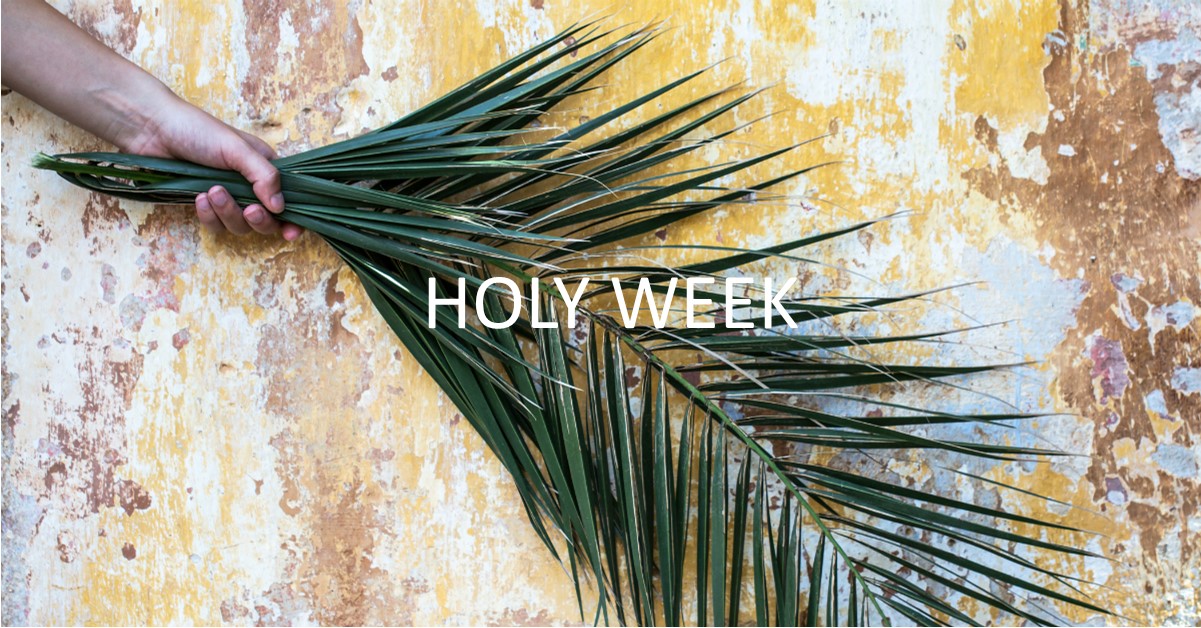Holy Week / Day 8
More Than A Day
April 17 // EASTER sunday : the resurrection of the lord
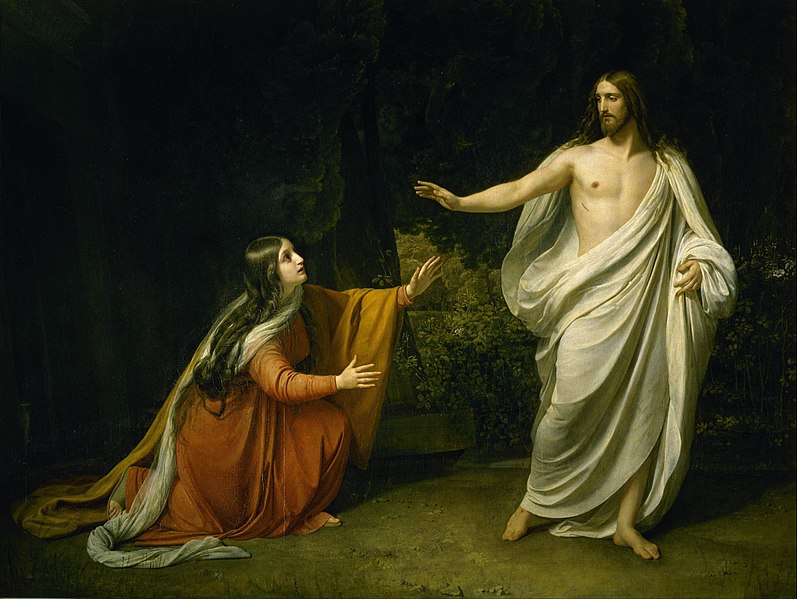
Readings : Acts 10:34a, 37-43; Colossians 3:1-4 or 1 Corinthians 5:6b-8; John 20:1-9
SCRIPTURE :
“This man God raised on the third day . . .” Acts 10:40
REFLECTION :
Easter Sunday. I confess, however, to a puzzlement I used to have as I read Scriptures on this day. The Gospel reading seems a bit muted. Mary of Magdala discovers that the tomb is empty and races to tell Simon Peter and the beloved disciple, who confirm her discovery. Notice, however, that there is no appearance by the risen Jesus. Nor any announcement by angels at the tomb that Jesus has been raised from the dead. The final verse even states that the disciples “did not yet understand the Scripture that he had to rise from the dead.” This is Easter Sunday, for crying out loud. Why not more fireworks?!? There is the detail about Peter’s seeing the burial cloths, with the cloth that covered Jesus’ head rolled up in a separate place. A most significant detail! It’s John’s way of suggesting, even at this early moment in the story, that something marvellous is afoot. Jesus has put aside the cloths of death’s sleep, folding them up like pyjamas, and has left the tomb for good. What I’ve come to appreciate is that the mysteries of Easter—God’s vindication of all that Jesus taught and did; the victory of life over death; the overcoming of sin by grace—are so marvellous that one day cannot do them justice. In fact, Easter “Day” is an octave of eight days in the Church’s liturgy. We have this entire week to hear the stories of the appearances of the risen Jesus to his followers. Moreover, we have fifty days to joyfully celebrate Easter, culminating in the feast of Pentecost, God’s outpouring of the Spirit of life. The Lord is risen; he is risen indeed!
MEDITATION :
The empty tomb is a profound symbol of Christian faith. The emptiness is its own Easter proclamation: there is no death here! We may yearn for that encounter with the Risen One, but it is not required. We do not need proof—we believe. The tomb of Christ is not the dark end but the light-filled beginning.
PRAYER :
Lord Jesus Christ, Risen One, we offer you every thought of our minds, every step of our feet, every loving action of our hands, and every prayer we have spoken on this Lenten journey. As we stand in the emptiness of this wondrous tomb, fill us with your light and love as we proclaim your resurrection from the core of our being: Alleluia: Alleluia! Alleluia!
REFLECTIONS ADAPTED FROM : Not By Bread Alone by Amy Ekeh, Thomas D. Stegman SJ
IMAGE : Christ’s Appearance to Mary Magdalene after the Resurrection by Alexander Ivanov 1835
Holy Week / Day 7
Journey To The Tomb
April 16 // HOLY SATURDAY AND EASTER VIGIL
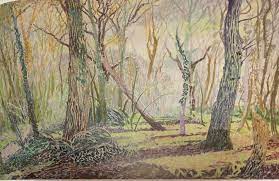
Readings : Genesis 1:1-2:2 or 1:1, 26-31a; Genesis 22:1-18 or 22:1-2, 9a, 10-13, 15-18; Exodus 14:15-15:1; Isaiah 54:5-14; Isaiah 55:1-11; Ezekiel 36:16-17a, 18-28; Romans 6:3-11; Luke 24:1-12
SCRIPTURE :
At daybreak on the first day of the week the women who had come from Galilee with Jesus took the spices they had prepared and went to the tomb. Luke 24:1
REFLECTION :
Our Lenten journey has brought us here, to this quiet moment of “already but not yet.” It is a place where we are strangely comfortable, and yet perpetually uncomfortable. Comfortable because we are so accustomed to living “in-between.” Uncomfortable because we want to finally arrive. Today’s reflections, with its litany of ancient readings, begins with the spirit of God sweeping across the waters. With that first command of God that light be scattered across our world, a drama of relationship, covenant, and redemption began. That drama plays out in our everyday lives, in chapels and churches, even more in kitchens and cubicles. The last reading for today’s reflections is the Gospel which begins, fittingly, with a reference to “daybreak.” From light to light we go, searching for the glory of the risen Christ.
The women come to the tomb expecting to find a dead body, ready to anoint it. But the body is not there. Peter, running to the tomb, also seems to expect a body: bending down and looking inside, he sees for himself the emptiness of the tomb, the burial clothes cast aside. Holy Saturday is a day when we accept and even celebrate the “in-between” reality of our lives. We know he is raised. We have seen his glory! And yet we still come to the tomb again and again, prepared for something different—just in case—needing to see for ourselves. This is the empty tomb, where the Spirit of God hovers, where the light has broken in. Our journey has brought us here. We have arrived.
MEDITATION :
Our Easter meditation is the pinnacle of liturgical celebrations. In addition to the litany of Scripture readings, we experience the lighting of the paschal fire, the clanging of bells and joyous singing of Alleluia. All in celebration of the victory of Christ over the grave. How have I experienced new life at Easter celebrations?
PRAYER :
God of life, open our hearts to the newness of life we celebrate. Thank you for leading us on our Lenten journey. Help us to bear witness with our joy to the resurrection of your Son.
REFLECTIONS ADAPTED FROM : Not By Bread Alone by Amy Ekeh, Thomas D. Stegman SJ
IMAGE : Easter Saturday, 2010, Mark Cazalet
Holy Week / Day 6
Love Perfected
April 15 // FRIDAY OF THE PASSION OF THE LORD [GOOD FRIDAY]
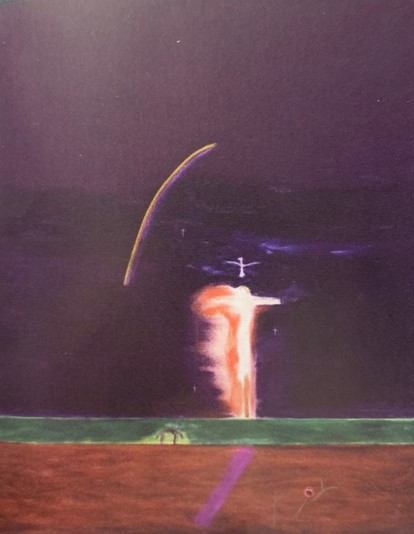
Readings : Isaiah 52:13-53:12; Hebrews 4:14-16; 5:7-9; John 18:1-19:42
SCRIPTURE :
“It is finished.” And bowing his head, he handed over the spirit. John 19:30
REFLECTION :
Easter Friday is such a climax of emotions. I’m imagining those at the cross and their facial expressions. The pain of loss. The grief of a mother. Those faces reflect a myriad of emotions and feelings—sorrow and suffering on the one hand, gratitude and tender love on the other. Here, on Easter Friday the Scriptures are rich in their descriptions. And what a wealth of riches to contemplate: the fourth Servant Song from Isaiah; the image of Jesus as high priest who sympathises with our weaknesses; and the passion according to John. Let’s focus on Jesus’ last words. First, he looks down from the cross at his mother and the beloved disciple. Even in his torment, Jesus offers comfort to and provides for his mother. His words to both figures symbolise the family of faith he has created, the family of the Church that will be nourished by the sacraments, signified by the outpouring of water and blood from his pierced side. Next, Jesus cries out, “I thirst” Physical thirst, certainly. But even more, his thirst that we receive his offer of love. It’s that offer of love that is reflected in Jesus’ last words: “It is finished.” The Greek verb here connotes more than an ending; it means bringing something to its accomplishment even to perfection. Jesus came to reveal the love of God. The cross, upon which Jesus opens wide his arms, expresses most fully the extent of his love for us. No wonder people are so reverent when thinking of the Cross.
MEDITATION :
Spend some quiet time in prayer over the Scriptures for today (and maybe even before an empty cross)—at church, at home, or even outside. Meditate on Jesus’ words: “I thirst.” Jesus was experiencing the excruciating discomfort of a man dying a violent death—and the deep spiritual yearning for a connection with each of us. Your presence, your time with Christ crucified, is a response to his thirst.
PRAYER :
Jesus, as I think over what you did on the cross today, I imagine your arms outstretched, a sign of your great love for me and for all people. You have given yourself completely, perfectly. It is finished.
REFLECTIONS ADAPTED FROM : Not By Bread Alone by Amy Ekeh, Thomas D. Stegman SJ
IMAGE : Crucifixion, 2008, Craigie Aitchison
Holy Week / Day 5
All Things Converge
April 14 // HOLY THURSDAY
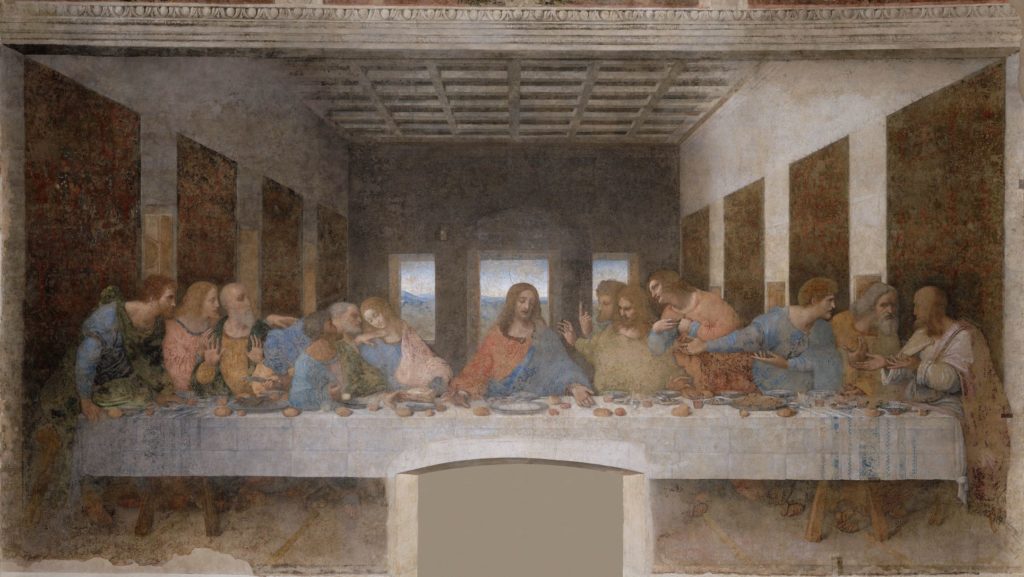
Readings : Exodus 12:1-8, 11-14; 1 Corinthians 11:23-26; John 13:1-15
SCRIPTURE :
In the same way also the cup, after supper, saying, “This cup is a new covenant in my blood. Do this, as often as you drink it, in remembrance of me.” 1 Corinthians 11:25
REFLECTION :
One could argue that every essential theme of the Bible converges on Holy Thursday—on this holy night that is like no other, a night when a new covenant was cut and an old one deeply cherished. Where do we begin to wrap our minds around what happened on this night? The yearly celebration of Passover, a “perpetual institution,” has for countless generations been the great “memorial feast” of Judaism [Exodus 12:14]. It is a celebration of liberation and love, a night when Israel lays claim to a special status: the liberated people of God. The consumption of the roasted lamb and the bitter herbs, and the retelling of the great story of the exodus, are a living memory of a moment in time that declares for all eternity that God cares for what God has made. At his last meal with his disciples, through both meal and service, Jesus perpetuated this living memory and called it “new”. A Passover meal was celebrated with new symbolism that did not negate the old but built upon it. The Master washed the feet of his disciples—another living symbol that spoke profoundly of God’s own self-giving, God’s willing condescension, God’s deep love for what is small and humble. Covenant, meals, service, humility, love that does not count the cost—all sacred things converge on Holy Thursday. With all of the created world—past, present, and future—let us rejoice on this holy night as God takes care of what God has made.
MEDITATION :
Interestingly, the Gospel account we read tonight is the only one that focuses on another action at the Last Supper, Jesus’ washing the feet of his disciples. The liturgy thereby teaches that a people of the Lord’s Supper should be characterised by their loving service of one another.
PRAYER :
Lord Jesus, I thank you for the most precious gift of your Body and Blood in the Lord’s Supper. May it inspire and empower me to offer foot-washing love to my brothers and sisters.
REFLECTIONS ADAPTED FROM : Not By Bread Alone by Amy Ekeh, Thomas D. Stegman SJ
PHOTO CREDIT : By Leonardo da Vinci – High resolution scan by Haltadefinizione in collaboration with the Italian ministry of culture. Scan details, Public Domain
Holy Week / Day 4
Betrayal
April 13 // WEDNESDAY OF HOLY WEEK
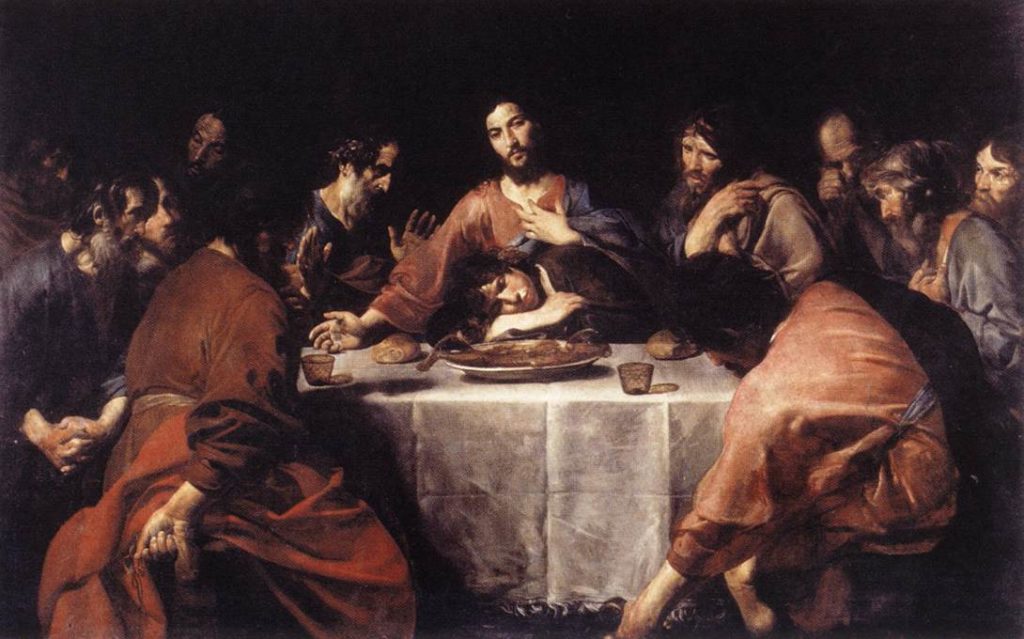
Readings : Isaiah 50:4-9A; MATTHEW 26:14-25
SCRIPTURE :
“Amen, I say to you, one of you will betray me.” Matthew 26:21
REFLECTION :
When I was young, I remember the intrigue of ‘betrayal’ surrounding this story of Judas. And intrigue there is, as Judas confers with the religious leaders about an asking price. But the reality is that today’s Gospel reading is about betrayal, and there is nothing cool about that. Jesus is betrayed by an intimate, by one whom he chose to be an apostle, by one who had accompanied him through-out his ministry of proclaiming God’s kingdom. He is betrayed by one with whom he had shared bread many times; indeed, in today’s reading, Judas “dipped his hand into the dish with [Jesus].” And, as the story proceeds, Judas will identify Jesus as the one to be arrested by offering a kiss, a gesture that grossly twisted its typical conveyance of peace. The purpose here is not to pile on Judas, but to highlight what a terrible thing betrayal is. Sadly, betrayal is something that many people experience. These can take consolation knowing that they have as Lord one who empathises with them. One who, as the third Servant Song from Isaiah declares, knows how to speak to the weary a word that will encourage them. The betrayal of Jesus was the beginning of many sufferings he bore on his way to the cross. Like the Servant, he was able to endure because he knew God’s help. As we arrive at the high point of our Easter meditations, we will have occasion to see that, while betrayal sets in motion the saving events we will celebrate, it does not have the final word. God’s love and power to save through Jesus have the last say.
MEDITATION :
Jesus has experienced the pain of strained or broken relationships: the betrayal of Judas, the sleepiness of his friends in the garden, their desertion at his arrest and death. Human relationships are messy; Jesus is no stranger to that fact. Offer Jesus a relationship in your life that is in need of healing. Pray this week that the reconciling love of the cross may have the final word.
PRAYER :
Jesus, forgive my betrayals, my sleepiness, and my desertion. Replace my weakness with faithfulness so that even when I sleep, my heart will be awake with you. [Song of Songs 5:2]
REFLECTIONS ADAPTED FROM : Not By Bread Alone by Amy Ekeh, Thomas D. Stegman SJ
IMAGE : By Valentin de Boulogne, The Last Supper. Created between 1625 and 1626.
Holy Week / Day 3
An Endless Moment
April 12 // TUESDAY OF HOLY WEEK
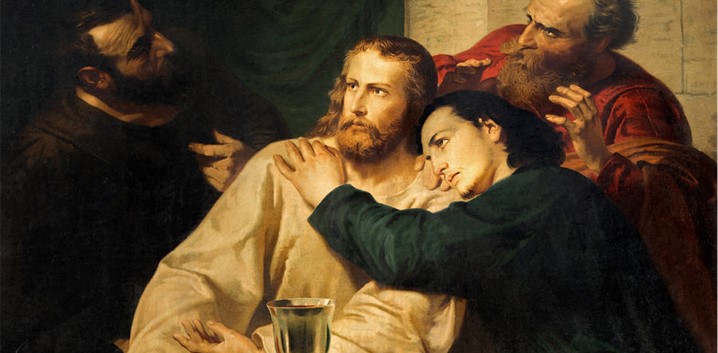
Readings : Isaiah 49:1-6; JOHN 13:21-33, 36-38
SCRIPTURE :
Reclining at table with his disciples, Jesus was deeply troubled . . . John 13:21a
REFLECTION :
Few scenes in Scripture are as intimate as Jesus’ last meal with his disciples. We imagine them in a darkened room, candles flickering, a small space, quiet voices. We wonder what everyone was thinking and feeling. Jesus had been predicting his death, and now he speaks of betrayal and of going away. There was surely an intensity about him that the disciples would have detected. Today’s Gospel tells us that, sitting at the table with his disciples, Jesus was “deeply troubled.” To imagine Jesus troubled is both comforting and disturbing. The evangelists do not shield us from the emotions of Jesus. During his ministry, we see anger, exasperation, and grief. As death draws near, we see dread, distress, and a troubled spirit. Neither life nor death is easy. The moments in the Upper Room were precious ones between Jesus and his friends. True, the moments were filled with misunderstanding, confusion, and even betrayal. And yet the bond of living and traveling together, of listening and learning—of loving one another filled the room, too. I like to think time was suspended for those seemingly endless moments: eating together one last time, praying and singing ancient songs, the quiet murmuring of conversations, the instant hush when Jesus spoke. Have we ever had such an endless moment with Jesus of Nazareth? Have we hushed our own souls to listen? Will we enter into his distress and allow our own emotions to create intimacy between ourselves and Jesus as the cross draws near?
MEDITATION :
Intimacy with Jesus is also signalled in the Gospel reading by the reference to the disciple “whom Jesus loved” resting against his chest. The beloved disciple is never named in John’s Gospel. One reason is that he serves as a model for all of Jesus’ disciples. As John depicts Jesus in the Prologue as being at the Father’s bosom from eternity [1:18], so now he employs the same word, kolpos, to describe the beloved disciple’s resting against Jesus’ chest. Each one of us is invited to that intimacy with the One who tenderly washes our feet and offers himself to us as the Bread of Life.
PRAYER :
Lord Jesus, draw me close to you. Help me to live as your beloved disciple.
REFLECTIONS ADAPTED FROM : Not By Bread Alone by Amy Ekeh, Thomas D. Stegman SJ
IMAGE CREDIT : Jesus and St. John at Last Supper from 19 Century in St. Michaels Church [Michelskerk] photo by Jozef Sedmak.
Holy Week / Day 2
Anointed
April 11 // MONDAY OF HOLY WEEK

Readings : Isaiah 42:1-7; JOHN 12:1-11
SCRIPTURE :
“Let her keep this for the day of my burial.” John 12:7
REFLECTION :
We so easily refer to Jesus as “Christ” that the latter is tantamount to a last name. “Christ” is not a surname, however, but a title. It means “Anointed One,” typically rendered “Messiah.” At the beginning of his ministry, Jesus interprets the outpouring of the Spirit at his baptism as an anointing that will lead him to bring good news to the poor, sight to the blind, and freedom to captives [Luke 4:14-21; cf. Isaiah 61:1-2]. In today’s Gospel, near the end of his life and ministry, Jesus receives another anointing, from Mary of Bethany. Mary’s anointing with costly oil is an extravagant gesture of love for Jesus, who defends her gesture, interpreting it as an anticipatory burial anointing. Messiah he is, but one whose mission includes suffering and death. The first reading, from Isaiah, is the first of four songs of “the Servant of the Lord.” We will hear all four Servant Songs during Holy Week, culminating on Good Friday. From early on in the Church (likely starting with Jesus himself), the Servant described in these songs has been understood to illuminate Jesus’ ministry and, especially, his suffering and death.
Today’s reading evokes much of what Jesus set forth at the outset of his ministry—e.g., opening the eyes of the blind, bringing forth captives from the dungeon. The song also accents the Servant’s nonviolence and gentleness (“Not crying out, not shouting, / . . . A bruised reed he shall not break”). The gentleness of the Servant is not weakness, but rather is an expression of power, the power of love. Something to keep in mind throughout the week as we prayerfully contemplate Jesus, the suffering Messiah.
MEDITATION :
Mary used so much oil to anoint the feet of Jesus that “the house was filled with the fragrance of the oil.” Her extravagance was in proportion to her love. How will we give extravagantly to Jesus? With what act of service will we show our boundless love this Holy Week?
PRAYER :
Jesus, the presence of your friends Mary, Martha, and Lazarus was a comfort to you as you neared the end of your life. May we be a comforting presence to all we encounter, ready to relieve their suffering in any way we can.
REFLECTIONS ADAPTED FROM : Not By Bread Alone by Amy Ekeh, Thomas D. Stegman SJ
IMAGE CREDIT : A Woman Anoints the Feet of Jesus by James Tissot.
Holy Week / Day 1
Enter the Story
April 10 // Palm Sunday
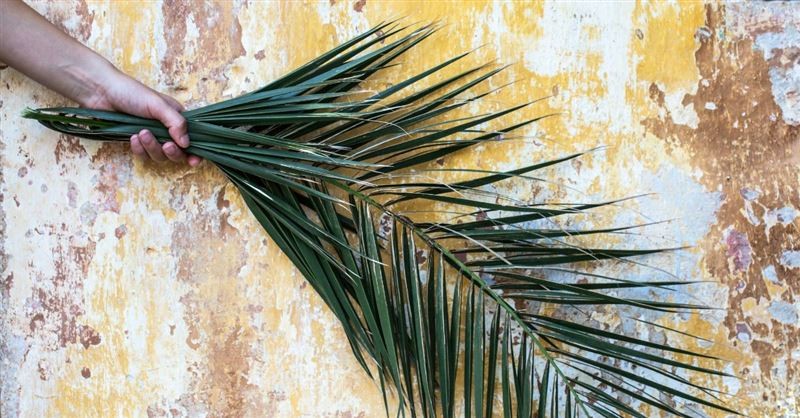
Readings : Luke 19:28-40; Isaiah 50:4-7; Philippians 2:6-11; Luke 22:14-23:56 or 23:1-49
SCRIPTURE :
And now as he was approaching the slope of the Mount of Olives, the whole multitude of his disciples began to praise God aloud with joy for all the mighty deeds they had seen. Luke 19:37
REFLECTION :
I don’t know if you have ever experienced actually using palms on Palm Sunday at church. I can just imagine children having fun with them as they are passed down the row, held in the air, wiggled and waved, gripped in palms of every size, from largest to smallest. Waving palms on Palm Sunday is an old tradition. We do it like we do so many things in liturgy—with our bodies as well as our minds, hearts, and voices. We feel the smoothness of the palm in our hands, we see its sleek lines and its pale green colour, we feel the air move as we wave it, we see how many fill the church, we feel the energy in the room. With this day—with this movement and this liturgy—we move into the dance, the ceremony of Holy Week.
When we reach out and take the palm, we commit ourselves to an ancient story and our part in it. We become the crowd. The Pharisees were scandalised by the shouting and praising and joy of the welcoming crowds, all because of Jesus. They told Jesus to silence his disciples, to make the people stop, as he approached the Mount of Olives. But Jesus didn’t stop the people, and he won’t stop us. We know what is to come. But for today, for now, we take up palms. We pass them down the row. We place one in every hand, largest to smallest. We enter the story.
MEDITATION :
We hear two Gospel readings today: Jesus’ triumphant entry into Jerusalem and the passion story. The people who jubilantly welcome Jesus’ yell, a few days later. “Crucify him!” Their fickleness contrasts with Jesus’ faithfulness. He enters the city riding on a beast of burden, not on a warhorse. In death, he embodies what he has taught: loving and forgiving his enemies; reaching out in mercy to the marginalised (i.e., the repentant criminal); praying with trust to his Father.
PRAYER :
Lord Jesus, as I hold my palm, help me to recall your faithfulness-and-love-unto-death.
REFLECTIONS ADAPTED FROM : Not By Bread Alone by Amy Ekeh, Thomas D. Stegman SJ

